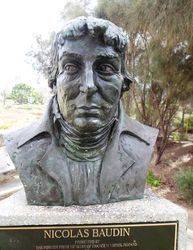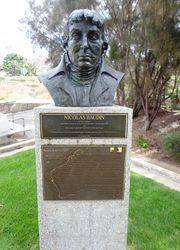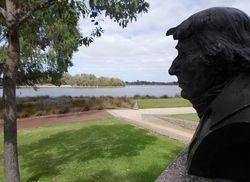
Home » Themes » People » Exploration
Nicolas BaudinPrint Page 
The bust commemorates French explorer Nicolas Baudin and the naming of Heirisson Island.
In 1798, Napoléon Bonaparte approved the organisation of a fully equipped exploratory expedition to Terres Australes. Nicolas Baudin, an experienced naval officer, was selected as the commander and was briefed by France’s leading scientists and major scientific institutions.
He was to study the natural sciences and collect living and preserved specimens of plants and animals. The expedition left Le Havre on 19 October 1800. For almost four years the two ships explored the western and southern coasts of Australia, and the island of Tasmania.
Location
| Address: | Riverside Drive, Fraser Point Reserve, East Perth, 6004 |
|---|---|
| State: | WA |
| Area: | Foreign |
| GPS Coordinates: | Lat: -31.964568 Long: 115.876344 Note: GPS Coordinates are approximate. |
Details
| Monument Type: | Sculpture |
|---|---|
| Monument Theme: | People |
| Sub-Theme: | Exploration |
| Approx. Event Start Date: | 1800 |
| Approx. Event End Date: | 1804 |
| Artist: | Peter Gelencser |
| Monument Manufacturer: | Kurandy Castings |
| Link: | https://sketchfab.com/3d-models/nic… |
Dedication
| Actual Monument Dedication Date: | Thursday 16th August, 2001 |
|---|
Nicolas Baudin
Presented by the former Prime Minister of France Michael Rocard to the Lord Mayor of Perth Dr Peter Nattrass
To commemorate the voyage of the French navigator and the baming of Heirisson Island.
16 August 2001
Plaque :
Baudin Expedition to Terra Australis (1800-1804)
On the 19th October 1800, the Baudin Expedition set sail from Le Havre in Normandy, France, with two ships, The Geographe and the Naturaliste. Captain Nicolas Baudin's second-in command was Emmanuel Hamelin. 23 scientists were engaged from the domains of astronomy, botany, zoology, mineralogy, horticulture and geography.
The ships anchored at present day Geographe Bay on 31st May 1801. First contacts were made here with the indigenous peoples. Midshipman Vasse was drowned. Separated by storms , the two captains charted the WA coast independently, from Cape Leeuwin to Joseph Bonaparte Gulf, including the Swan River and Heirisson Island, named for oneof the Ship's officers. Both ships carried out extensive work at Shark Bay.
Baudin's Expedition secured the most valuable natural history collection of its time- more than 200,000 specimens of flora and fauna were collected of which 2542 were new to science, doubling the number of known species. It was the first time live animals were transported, which later formed a small Australian zoo at the Empress Josephine's summer palace at Malmaison on the outskirts of Paris.
The expedition was responsible for hundreds of French place names in Australia, of which about 240 are still in use in WA. Baudin charted nearly two thirds of the Australian coastline, filling gaps in the rudimentary Dutch maps, making the first detailed charts of the west and north coasts of Western Australia and of the south-eastern coast of Van Diemen's Land.
A celebrated chance encounter on 8th April 1802 with Matthew Flinders gave the name to Encounter Bay, SA. After resting in the young colony of Port Jackson, Baudin returned to WA, carrying out extensive research at King George Sound. Baudin died of Tuberculosis on 16th September 1803 at Ile de France (Mauritius) on the return journey. The expedition, now under the command of Milius returned to Lorient in Brittany in March 1804.
Terra Australis 2001 WA Association Inc
Centenary of Federation Western Australia







